|
|
|
Sort Order |
|
|
|
Items / Page
|
|
|
|
|
|
|
| Srl | Item |
| 1 |
ID:
120105


|
|
|
|
|
| Publication |
2013.
|
| Summary/Abstract |
China's economic rise has transformed the global economy in a number of manufacturing industries. This paper investigates whether China's transformative influence extends to the new green economy. Drawing on the debate about how China is driving major economic changes in the world - the "Asian drivers" debate - it identifies five corridors of influence and investigates their relevance for the wind energy industries. Starting with the demand side, it suggests that the size and rapid growth of the Chinese market have a major influence on competitive parameters in the global wind power industry. While Western firms have found ways of participating in the growth of the Chinese market, the government's procurement regimes benefit Chinese firms. The latter have invested heavily and learned fast, accumulating production capabilities that have led to changes in the global pecking order of lead firms. While the combined impact of Chinese market and production power is already visible, other influences are beginning to be felt - arising from China's coordination, innovation and financing power.
|
|
|
|
|
|
|
|
|
|
|
|
|
|
|
|
| 2 |
ID:
143556
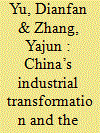

|
|
|
|
|
| Summary/Abstract |
China’s industrial transformation faces four big roadblocks: the loss of traditional comparative advantage, weak domestic demand, low-end locking of the value chain, and structural and institutional obstacles. The shift of economic growth to structural upgrades, innovation and a service-based economy is the primary driving force required. China should implement four strategies. The first is to cultivate a new dynamic comparative advantage and inject new vitality for industrial transformation. The second is to let the market play a more decisive role and establish a long-term mechanism to expand domestic demand. The third is to promote the convergent development of global and national value chains, upgrading the value chain in horizontal and vertical axes. The fourth is to create an upgraded version of Chinese reform, manage the market with a pattern of negative listing and supervise the government with a pattern of positive listing.
|
|
|
|
|
|
|
|
|
|
|
|
|
|
|
|
| 3 |
ID:
152948


|
|
|
|
|
| Summary/Abstract |
This article will adopt a long-term perspective on the possible evolutions of the respective role of China and Europe in the global division of labour and in international trade and how it affects the flow of Chinese outward direct investments in Europe. The Chinese leadership has been pursuing an active industrial policy to enable its national champions to move up the value chain and challenge the European incumbents. In that context, Chinese authorities have been fostering strategic asset-seeking outward direct investments by Chinese firms in the European Union to capture technology and management know-how by taking over European enterprises weakened by the crisis. This new challenge affects very differently the various European Union member states according to their level of technological development and their role in the regional division of labour between the economic centre and the periphery of the European Union. This analysis will explain the evolution and distribution of Chinese outward direct investments in Europe and provide elements for a prospective analysis of this phenomenon.
|
|
|
|
|
|
|
|
|
|
|
|
|
|
|
|
| 4 |
ID:
144824
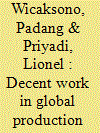

|
|
|
|
|
| Summary/Abstract |
Despite growing investment from leading automotive makers, particularly Japanese companies, the Indonesian automotive sector is still struggling to ensure decent work. This article makes a particular attempt to analyse the close links between Decent Work (DW) and Global Production Networks (GPNs) in the Indonesian automotive sector, whilst scrutinizing the existing literature that has covered the two concepts in separate frameworks. More specifically, this article examines the employment opportunities and adequate earnings of local employees within the DW framework in the country’s automotive sector with the expansion of GPNs. It finds that although there were greater opportunities for skilled workers to upgrade capabilities and enjoy improved welfare outcomes, there are still many more less-skilled workers remaining in precarious conditions.
|
|
|
|
|
|
|
|
|
|
|
|
|
|
|
|
| 5 |
ID:
143529


|
|
|
|
|
| Summary/Abstract |
Bangladesh’s success in the global apparel value chain following the expiration of the Multi-Fibre Arrangement in 2005 deserves study to understand how a least developed country can become a major source of apparels within a short period of time. This article shows that even under a quasi-hierarchical governance structure, suppliers in Bangladesh have made significant progress in economic upgrading, particularly process and product upgrading. Competitive pressure linked to the ‘open sourcing’ of apparels has caused leading firms to ease conditionalities on the production process. Preferential access to major markets, timely responses to buyers’ changing demands, favourable policies related to the import of raw materials, production and export of apparels and new labour-related policies have facilitated economic upgrading. Suppliers have accordingly benefited from substantial investment in productive capacity, technological know-how and workers’ skills. Further upgrading would require more investment in firm-level productivity and improvement in physical and social compliance.
|
|
|
|
|
|
|
|
|
|
|
|
|
|
|
|
| 6 |
ID:
147895


|
|
|
|
|
| Summary/Abstract |
This article estimates the effect of integration with global apparel value chain on performance of Bangladesh apparel firms. The study does it by estimating an augmented Cobb–Douglas production function. The findings show that both backward linkage with foreign suppliers of intermediate inputs and forward linkage with global retailers of apparels positively affect firms’ output and labour productivity. By contrast, backward linkages with local suppliers have adverse effects on firm performances. The findings imply that it is a firm’s integration with the global apparel value chain, not the conventional backward linkage with domestic suppliers, that defines success of Bangladesh apparel industry in a globalizing world.
|
|
|
|
|
|
|
|
|
|
|
|
|
|
|
|
| 7 |
ID:
153053
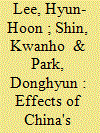

|
|
|
|
|
| Summary/Abstract |
The Chinese economy is slowing down and is in the midst of a structural transformation from export-led and investment-led growth to domestic demand-led and consumption-led growth. While there are widespread concerns among China's trading partners about the effect of the slowdown in China's growth on their exports, China's structural changes are also likely to have a significant impact: for example, China will import fewer machines and more cosmetics. The central objective of the present paper is to empirically examine the effect of China's structural transformation on the exports of East Asian economies, which have close trade linkages with China. We find that economies that have failed to increase the share of consumption goods in their exports to China have suffered larger declines in their quantities of exports to China. In addition, economies that have suffered losses in their shares of China's parts and components imports have faced reductions in their shares in China's total imports.
|
|
|
|
|
|
|
|
|
|
|
|
|
|
|
|
| 8 |
ID:
167872
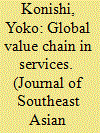

|
|
|
|
|
| Summary/Abstract |
This paper assesses the role of global value chains (GVCs) in services and identifies the sector's contributions towards the expansion of the Japanese economy. Specifically, the analysis focuses on the tourism sector in Japan, which has been witnessing rapid growth in recent years. Tourism is also a highly tradeable sector that, directly or indirectly, affects various services industries like transport, retail, wholesale, restaurant, agricultural production, inter alia. In order to better understand the sector, the paper develops its GVC map and estimates the ripple effects of the inbound tourism boom on Japan's economic development using an Input-Output (I-O) table.
|
|
|
|
|
|
|
|
|
|
|
|
|
|
|
|
| 9 |
ID:
154537
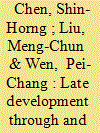

|
|
|
|
|
| Summary/Abstract |
This research note investigates the nature of Taiwan's economic links with Southeast Asia. While it is assumed that the economic links are driven by investment and formal trade agreements, we identify a more intertwined dynamic of "deep integration" through Global Value Chains (GVCs). We first examine the macro data of Taiwanese direct investment and bilateral trade with ASEAN member countries. Next, we discuss "the trade-investment-service-IP nexus" through the case of the textile and apparel industry in Taiwan, which evolved with the GVC led by brand marketers in advanced countries, cementing economic linkages between Taiwan and Southeast Asia. We then explore new patterns of Taiwanese development through exporting "good enough innovations" and "total solutions" in the region.
|
|
|
|
|
|
|
|
|
|
|
|
|
|
|
|
| 10 |
ID:
167871


|
|
|
|
|
| Summary/Abstract |
This paper aims to analyse the current position and potential for upgrading of the Philippines in the global value chain of information technology offshoring services. With its rapid growth in the last decade, the Philippines is characterized as strong in voice and is expanding in the non-voice and more complex services sectors. Applying the IT offshoring services framework introduced by the Duke Center on Globalization, Governance and Competitiveness (CGGC) GVC, the analysis shows that the industry's upgrading strategy could pursue the following trajectories: first, upgrading from business process outsourcing (BPO) to knowledge process outsourcing (KPO) especially in medical, financial and legal services; second, expansion and upgrading within information technology outsourcing (ITO); and third, inter-sectoral upgrading to verticals or industry-specific activities, particularly shared services companies, game development, and engineering design in manufacturing. The results of the study indicate that human capital development will be critical in upgrading the Philippines in the information technology and business process management (IT-BPM) global value chain (GVC).
|
|
|
|
|
|
|
|
|
|
|
|
|
|
|
|
| 11 |
ID:
171435
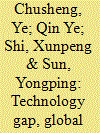

|
|
|
|
|
| Summary/Abstract |
The technological progress of a country may mean that its technology gap compared to the frontier has changed, which will induce a change in its positioning in the global value chain and affect its carbon intensity. Using paten data, Input Output Database and the Global Value Chain Index, we employ systematic Generalized Method of Moments, quantile regression with panel data and multilevel mediation analysis to measure empirically the impact of the technology gap on carbon intensity and positioning on the global value chain. The empirical analysis shows that narrowing the technology gap will reduce significantly a country's carbon intensity. Further, the effect of the technology gap on carbon intensity is more pronounced on industries with higher carbon intensity. The mechanism test using the mediation effect model proves that the impact of the technology gap on carbon intensity is achieved by changing in the position of global value chain. The findings suggest that a country's carbon intensity performance is not only affected by its own technological progress, but also by global frontiers. Therefore, a country should not only pay attention to its own technological progress but also to the development of global frontier technologies and speed of technological progress.
|
|
|
|
|
|
|
|
|
|
|
|
|
|
|
|
| 12 |
ID:
164728
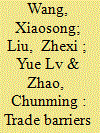

|
|
|
|
|
| Summary/Abstract |
This paper investigates the effects of trade barriers on China's participation in the global value chain (GVC) using a thorough decomposition approach for trade volume, total exports, final exports and intermediate exports. Our econometric results indicate that anti‐dumping (AD) measures initiated by trade partners have restrained the process of China's participation in the GVC. From 2000 to 2014, AD measures reduced the foreign value‐added rate of total, final and intermediate exports by 4.5 to 28.7 percent, 3.4 to 17 percent and 1.2 to 8.5 percent, respectively. In addition, suffering the effects of AD measures, China's GVC position index declined by 8.2 percent to 28.6 percent during this period. Moreover, AD measures have increased industries' upstream index by 3.2 to 13.7 percent over the same period. These results imply that both the petition and approval of AD cases has had a negative influence on the extent and position of China's GVC participation.
|
|
|
|
|
|
|
|
|
|
|
|
|
|
|
|
| 13 |
ID:
187845


|
|
|
|
|
| Summary/Abstract |
US multindoational enterprises sell considerable amounts of products to China's domestic consumers that are “made” in either China or other countries. However, these sales are not counted as US exports to China. To account for this, we propose a beyond-borders approach to measuring trade flows that explicitly considers firm ownership, termed “trade in factor income (TiFI),” that defines the US-owned factor income induced by China's final demand as US exports to China. Applying this approach to OECD data, we find that on average from 2005 to 2016 in TiFI terms, US exports to China were 20.34% and 8.21% greater, China's exports to the US were 1.64% and 16.04% less, and the US trade deficits with China were 17.4% and 32.0% less than the trade figures reported in value added and gross terms, respectively. The concept of TiFI transforms trade measures from a territory-based “made in” label to a factor income-based “created by” label.
|
|
|
|
|
|
|
|
|
|
|
|
|
|
|
|
|
|
|
|
|